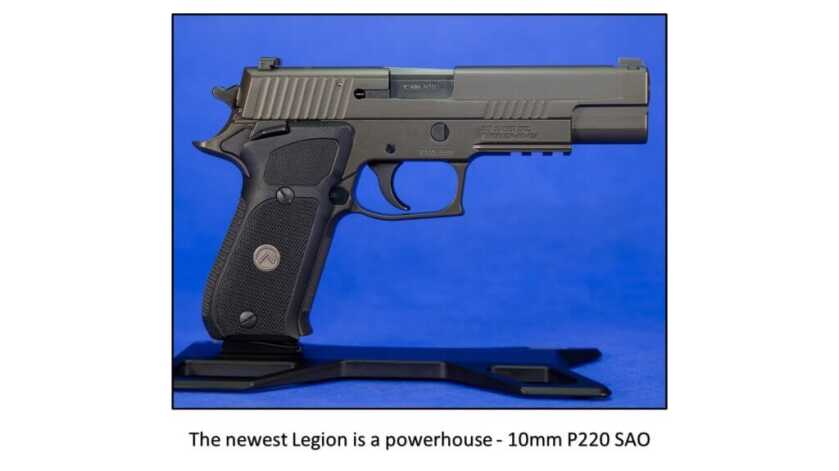
A couple of years ago, SIG Sauer announced that the P220 chambered for 10mm would join the Legion family, and I was excited. The word was that it would follow the release pattern of DA/SA first, then the single-action-only (SAO) would come later. I opted to hold out for the SAO, figuring it would be a more interesting gun and because at the time I had just done a review of the P220 Legion in .45 ACP. Had I known it would take more than two years, I might not have made that choice. But – as they say – good things are worth the wait, and this new Legion pistol proves that old saying to be, once again – true.
Turns out, the wait paid off well. Not just because of the SAO configuration and trigger, but because it’s a different pistol in many ways than the P220 Legion in DA/SA of two years ago. The frame of this handgun is constructed of solid stainless steel, rather than the standard alloy frame. This makes the handgun in 10mm almost a full pound heavier than the one chambered for .45 ACP. This is important in a couple of ways that I’ll get to in a minute – but first, let’s talk about what exactly a Legion pistol is.

WHAT IS A LEGION?
SIG Sauer introduced the Legion moniker about five or six years ago as an elite ‘top of the line’ series of handguns, with a sort of “by operators, for operators” theme. According to SIG at the time of the debut of the Legion, it was about taking the most common upgrades and after-market changes that people were making to their SIG Sauer classic line of pistols and producing an “out of the box” version with extra touches. The trademark touches to a Legion pistol are Black G10 grips with Legion medallion insert; SIG X-RAY sights; Generous checkering and undercut trigger guard; Improved trigger; Legion Gray finish with “Legion” engraving. This is, of course, all on top of what is one of the best production handguns made to start with. To enhance the Legion experience and help set it apart, SIG Sauer created a sort of Legion Tree House that only the cool kids get to hang out in. When you purchase a Legion gun and register the product with SIG, you get a membership to “Legion Only” areas of their website and access to purchase exclusive Legion branded accessories and swag. You also receive a special pistol case in Legion Gray (more on this in a moment) and a challenge coin specific to your model of Legion pistol. Sounds like the marketing department running unchecked, right? Maybe so, but I will tell you that I have purchased a few of the Legion holsters and other accessories and they are top-notch products, custom made, or coordinated to the guns. And let’s be honest – everyone likes to belong to the club once in a while.
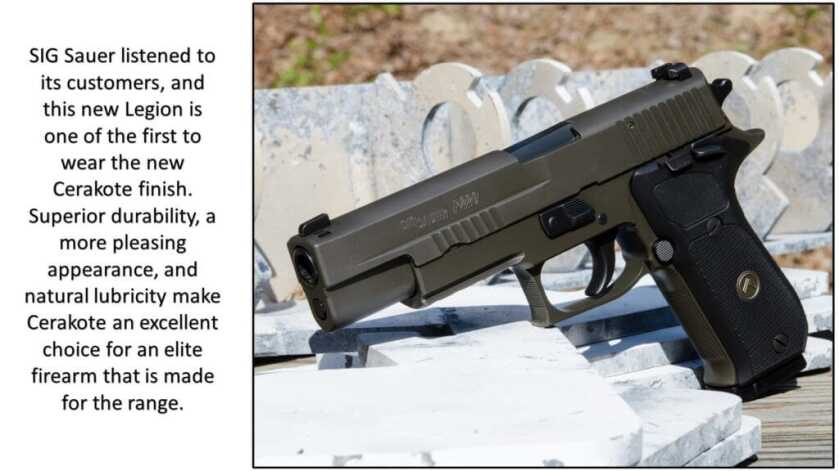
Okay, now you know what the Legion series is all about – so let’s talk about a few things that have changed recently. First, the Legion pistol case that SIG used to send out has been replaced with what I would describe more as a carry case. The original cases were a molded semi-rigid case with a custom foam insert that was pre-cut to exactly fit your pistol. It also had cuts for a magazine and a knife (a Legion knife, of course – sold separately) and the challenge coin. These cases were very nice, but I have to confess I found them a bit impractical. The case had no handle, so you could not carry it. And it was not suitable as a display case. All mine went directly into storage. SIG now sends a soft-sided case in a silvery-gray color with Legion logo on the exterior. The heavy-duty zippered case contains a padded pistol pouch for your gun on one side, a zippered pouch on the other, and generous elastic magazine loops. It also has sturdy double handles, and can actually be used as a nice carry bag. You’ll appreciate the quality of this soft case immediately – especially when you see that it is made exclusively for SIG Legion owners by 5.11 Tactical. This writer finds it to be a more practical case and another Legion-experience improvement.
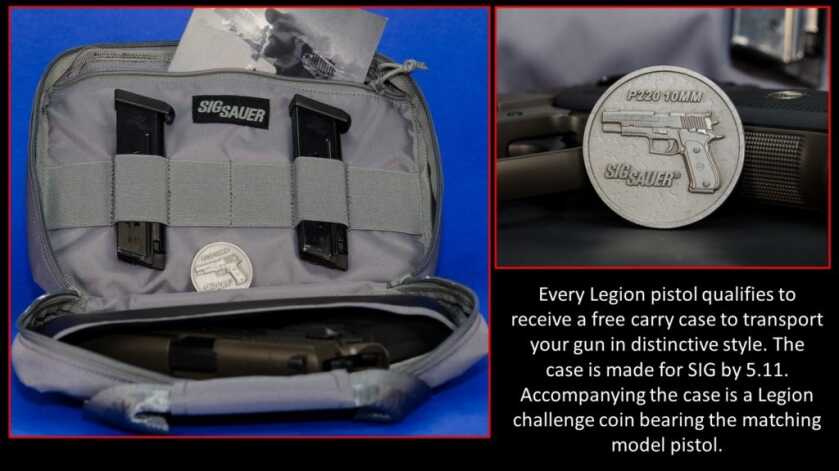
Another big change was the switch from a PVD finish to a Cerakote finish. I had not heard of that change prior to receiving the test gun, but the moment I opened the box I saw the difference. Cerakote has a different look than PVD – the former being ‘wetter’ look. Also, because different finish materials are used, the Legion Gray coloring is a shade more on the green side than it previously was. The subjectivity of color and hue aside, the switch to Cerakote is a positive move. The gray PVD was always troublesome to many Legion owners because it had a very dry – almost powdery appearance, and it would quickly wear thin in high friction areas like the slide rails. Cerakote is a thicker and harder coating and has some natural lubricity. Earlier Legion owners with PVD coatings should not despair, however – future collector’s value of the “first generation with PVD” pistols just went up.

The trigger of the SAO is not much different from its dual-mode counterpart in terms of physical shape or pull weight. The 10mm cartridge generates so much pressure and force that changes to the trigger group are difficult to make. It would still be nice to see something in the future from the master shop or Grayguns, but that is speculation at best. A short reach/short reset trigger can be placed in a P220 10mm but wasn’t in this case.

SHOOTING THE P220 SAO 10mm Legion
The P220 is, for all intents and purposes, the one that started it all for SIG Sauer. Its most popular early incarnation was in .45 ACP, and it became iconic among law enforcement, military, and civilian alike. As mentioned, the 10mm version is made entirely of stainless steel – frame and slide. This is due to the extreme pressures created by the 10mm cartridge (up to 37,500 psi). That construction puts this 5” barreled P220 at about 44 ounces – nearly a full pound heavier than the standard P220 with a 4.4” barrel and alloy frame. It also makes this gun a much tamer shooter than it might otherwise be. I shot everything from the lower-powered range ammo to the bear hunting loads, and at no time did I feel the recoil was excessive.

The X-RAY3 sights on the Legion continue to be among my very favorite on any handgun, and provide a fast acquisition combat sight picture, while still offering enough precision to take long carefully aimed shots. And because they contain Tritium® front and rear, you have an excellent 3-dot sight picture even in complete darkness. But daylight is where these sights really rock. The bright green ring that surrounds the Tritium® center of the front sight is almost eye-piercing when you raise the gun. The rear sight is serrated for anti-glare and finished in a matt black and the Tritium® dots are understated for better front sight focus.

I don’t do much double and triple tapping with 10mm’s, but it was nice to discover that you almost can with this pistol and keep the shots on target. Muzzle rise is on par with a 9mm pocket pistol – maybe even tamer than that. I also found the trigger to be very suitable during live fire, with more a combat feel than one of the target pistol. I found the gun easy to shoot well, both off-hand and rested. The ergonomics of the P220 fit my hands very well and this gives me my best chance to holding a steady sight picture and maintaining proper trigger control. The G10 offers fantastic friction without being in any way uncomfortable or sharp, and it wraps around to cover the rear. This is also true of the checkering on the frontstrap. Shooting a full magazine of defense load 10mm without having to re-adjust my grip is pretty convincing.
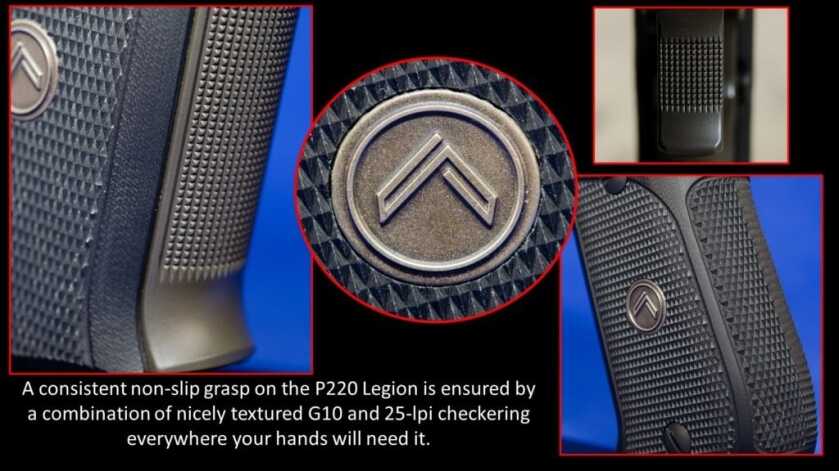
So, why single-action-only you ask? Personal preferences, really – it all comes down to the type of action you like best. Double Action/Single Action has many benefits, and is the standard action type for most SIG Sauer handguns – but there are those who just can’t deal with two types of trigger pulls, and want to know that their trigger will feel the same with every shot. That is the most common reason.
Another is that a single-action trigger can be tuned more easily most of the time because it has but one mode of operation. I won’t claim a preference – I appreciate each for what it brings to the table. In the case of this 10mm Legion, I made up my mind early on that I wanted to shoot the SAO. And while it does not have a short reset trigger, it is remarkably responsive and tactile. It is also very consistent and crisp – measuring on average exactly 5 ½ pounds. And because a single-action-only is… well, single action only – there is no de-cocker control to safely drop the hammer. But there is an ambidextrous manual thumb safety.
The safety on the P220 SAO operates much like that of a 1911 and is positioned and sized to about the same specs. It’s the same size on both sides of the pistol – so you lefties don’t have to make do with skinny, half-hearted control. When raised (engaged) there is a visible white dot to indicate that the pistol is on safe. It’s also wide enough to serve as a thumb rest, for you 1911ers. One of the features I like best about the safety on the P220 Legion is that you can fully manipulate the slide and all other controls – except the trigger – when it’s engaged. This means that administrative tasks such as loading/unloading and chambering a round can all be done with the safety on. You can even fully field strip the pistol with the safety engaged. The slide can be fully racked and the hammer need not be cocked to engage.

Fieldwork with this gun spanned a couple of range days and several hundred rounds of ammo. There were no malfunctions of any kind – not even a hint of one. And everything put through it found its mark. The accuracy of the 5” barrel combined with the fantastic sight picture makes even me feel like a marksman. Shooting off-hand from about 11 yards, I was able to consistently keep everything inside 3” groups. Rested tests at 20 yards performed even better, with the exception of a single round of Underwood that got away from me and made its group almost 4”. I generally shoot groups of five, and I always call out the best three from that group to help eliminate shooter errors such as that. I truly believe that the 3-shot numbers are more indicative of the performance capabilities of both gun and ammo.
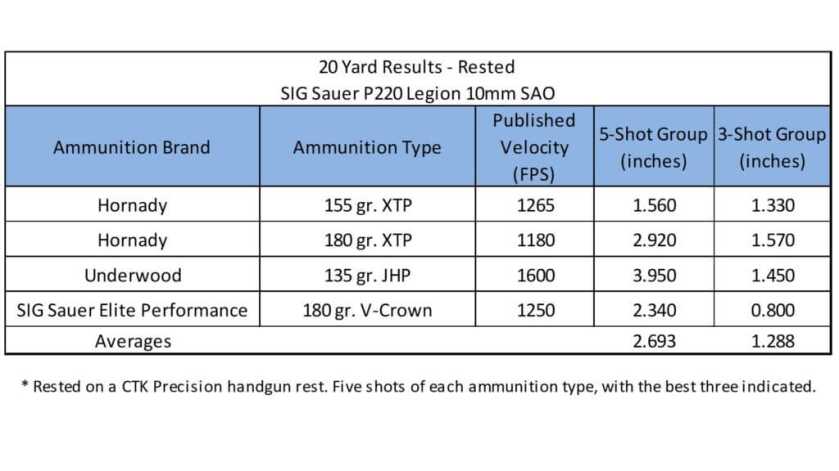

JUST MY OPINION
The Legion line has become a well-known segment of the SIG Sauer brand. Overall, I think the Legions do an excellent job of providing the “bells and whistles” version of each model offered, while simultaneously building its own recognizable value for the brand enthusiast. Doubtless, the marketing department had a hand in creating the Legion product line – but it was clearly driven by “gun guy” and/or “gun gals” to make it a reality. These guns are made by shooters, for shooters, with an element of smooth operator and classy collector thrown in. The extra swag and accessories – some free, some available for exclusive purchase – add to the Legion experience for owners. Your gun’s serial number will allow you to create an account on SIG’s special Legion website, where you can see products others can’t – and of course, purchase them. There are also exclusive deals to be had from time to time. It’s all part of being a grown boy and getting access to the treehouse. And if all that is of little interest to you, take heart knowing you have one of the finest production handguns made – an heirloom in itself.
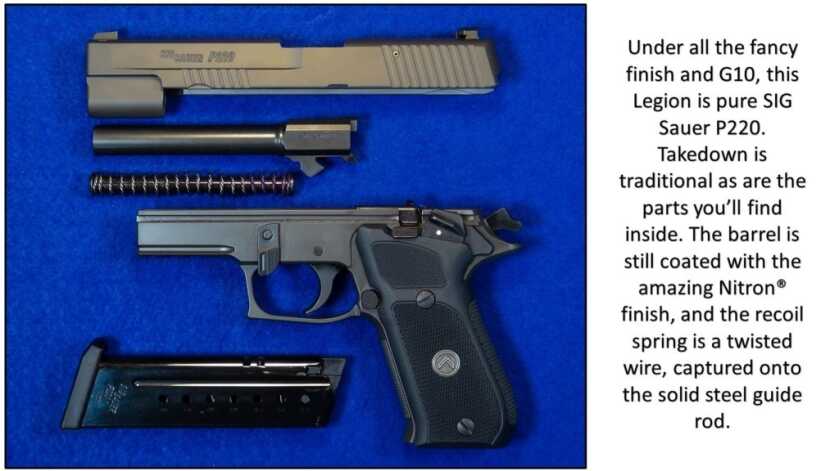

Thank you for a well written and detailed article. I appreciate the data driven storytelling. This is an excellent handgun; reliable, accurate and easy to use. It is one of my favorite SIG. Despite its size and weight, it carries great in the Legion OWB. The holster is an example of the Legion line offering tangible value for getting top notch essential gear.
There is one disappointing feature. I think SIG compromised on the trigger. At this price point it should have been made by the master shop. This SIG deserves to be uniformly awesome.
I know Sig pistols are expensive, I have a West German P226 (expensive at $600.00 back in 1992) and a Sig Pro that is a lot cheaper ($400.00 in 2000). There is always inflation but I can buy a high quality 1911 in 10mm for $600.00 less or a Glock for almost $900.00 less. The hype is nonsense. No doubt is a quality weapon but $1600.00 is going overboard and nothing gained in practical sense.
I purchased a beautiful Sig P220 10 mm elite SAO ( Stainless with rosewood grips ) a few years back. I love it. This new gun sounds exactly like it except for cosmetics and marketing hype. Any big differences?
I AM DISAPPOINTED THAT SIG DID NOT BUILD IN AN OPTIC READY (Red Dot) SLIDE..ALSO, I FIND GREAT VALUE IN THE SIG DECOCKER.
I’ve reviewed the specifications on the Sig, and am not impressed. I purchased the SA 6” 1911 in 10mm. Yes, not an every carry, but is great for backcountry treks.
Nice article. Quick question: what is the lever on the left side of the frame just ahead of the safety? On the sa/da version It’s the decocker. What purpose on the sa only version?
nice bear gun i like it
I’d rather have lighter weight, factory ported, and based on the 227 which is a double stack!!!! That would be the ultimate. Anything less is just less!!!!!!!!!!!!!!!
The 220 L is a beautiful piece of engineering and execution but why would anyone want SAO? It adds an additional and unnecessary step in time sensitive situations. Furthermore, an 8+1 magazine is antiquated; double stacking doesn’t mean unreliability anymore.
Sig makes great guns. No doubt. But to combine a high bore axis with a high powered round makes me wonder why. It would be interesting to do time trials between this gun and something with a lower bore axis like a G20 or some other similar type of pistol.
I guess quick follow-up shots are not a factor with this particular platform.
I carried a Stainless P220 in 45acp for many years and though it shot great it was one heavy gun, and I am 6’3″ @300lbs. I am a big 10mm fan but I just don’t see this gun as a need for me since I have 3 other 10mm (Stainless Colt Delta Gold Cup, Stainless S&W 1066 and Springfield Armory XDM) pistols.
Love shooting my SA/DO version. I could care less that it doesn’t hold fifty one rounds and I have to swap mags more often. It’s a tack driver at 25 yards, has a modest recoil, and zero problems shooting any ammo. The 45 version and the Legion p226 are also nice… but this one puts a smile on my face every time.
I already have the P220 in 10mm, stainless elite with rosewood grips. Same gun reviewed by Hicock45. Nice gun but needs the Master Shop flat faced trigger.
They missed the boat here. The 10mm should be put in the 227 !!!!
You guys may think you wouldn’t like this gun or see its purpose bc of the round count etc but trust me if you like 10mm or power at all you’ll love the 10mm p220 I prefer my hunter model but the biggest reason this gun will win over ur heart is because it feels like shooting a polymer frame 9mm no exaggerating I can shoot it every bit as fast and accurately as my p320
I have only 1 sig (p220 357sig) and it’s good. The 1 only reason I’m not going too buy this gun is 8 rounds only! Make a double stack 12 round minimum and count me in!
8 + 1 = NO Interest. Those days are over. You have to have better capacity for regular folk. The collector will buy this gun, and never shoot it, however the real gun guys have choices and we will pass on this. I’m a huge Sig fan so no hate just truth.
Nice gun, but not 1600$worth.give me a break!
Wow, that is expensive. I like the caliber, but for me, this is not an “Every Day Carry” gun. It is big and it is heavy, and the only part that intrigues me is the round it fires.
Sorry, but this is one I will pass on.
Big 10mm fan. Big Sig fan. 10mm 220? 8+1 on a $1600 budget? Meh…
They should have used the 227 frame as a starting point. The 220 platform was state of the art in 1975, now it’s long in the tooth and the “free” swag doesn’t make up for the price or capacity issues. I’ll pass.
Sorry Folks! I have been actively looking for a Pistol that Rivals my FNX-45! Still haven’t found one! At app$700 retail, 3 lb. 14 oz. with 16 45acp. rounds in it, 3 magazines that come with it. Muzzle rise about the same as a 9mm. The only thing nice about this Sig. Pistol are its sights! Love them!